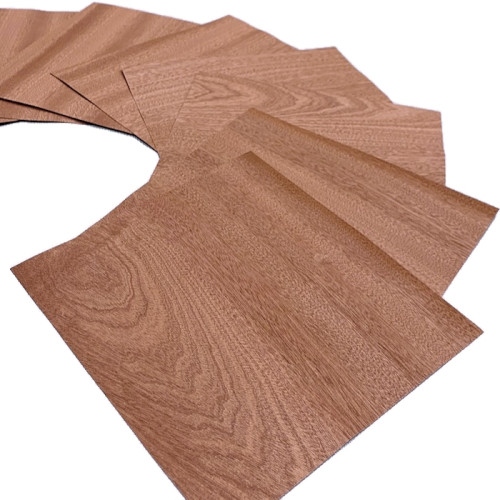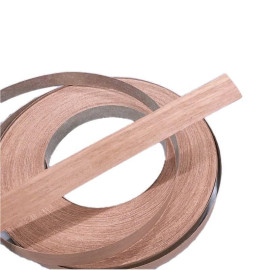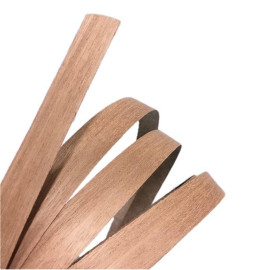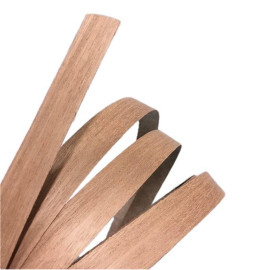
Sapelli XXL Small-size Veneers
Sapelli XXL Small-size Veneers
Genuine wood-sliced veneer sheets.
Selected single veneers, no sequence.
Fix length of 30 cm long.
Width: From 22 to 39 cm, depending on availability.
Thickness: 0.45 mm.
Sold by the sheet.
Sapelli XXL Small-size Veneers
Genuine wood sliced-veneer sheets.
Selected single veneers, no sequence.
Dimensions:
Fix length of 30 cm long.
Width: From 22 to 39 cm, depending on availability.
Thickness: 0.45 mm.
Sold by the sheet.
Measurement scaling:
The width is rounded to the covered centimeter, for example, 15.8 cm, giving 15 cm.
Photos:
To keep the cost of these products as cheap as possible and contrary to other veneers on this website, the pictures of small-size veneers do not represent the available stock.
What is Sapeli Mahogany wood?
Common names:
Sapelli, Sapele, Sapeli Mahogany.
Botanical name:
Entandrophragma cylindricum
Origin:
Sapelli is a type of African "red" wood. Although it is not a genuine mahogany, it is part of the same family.
Appearance:
This redwood is a stripy, quarter-sliced wood, giving the impression of alternating light and dark bands.
The quarter-sliced Sapelli may give the impression of a veined wood. But it’s not veined; this impression is given by the annual rings that have grown in opposite directions season after season.
If you place your finger on a light band and rotate it around your finger without moving the veneers, the band will turn dark, and so on.
Properties:
Density: 665 Kg/m3 (average weight at 10-12% moisture content).
Janka hardness: 6060 Newton (for comparison, Oak is 4980 N and Poplar is 1650 N).
Modulus of elasticity: 12.35 GigaPascal (for comparison: Ash is 12.31 GPa and Poplar is 9.75 GPa).
Note: This wood has good outdoor resistance. However, due to the thin veneer, it is not recommended for outdoor use unless it is embedded in an epoxy coating, such as for surfboards.
Uses:
This wood is a classic for cabinetry and joinery, and it is highly prized in guitar making and boat building.
What is veneer?
Veneers are thin sheets of wood obtained by slicing or peeling.
Their surface has the appearance of planed wood without any finish or treatment. They are neither glued nor backed with any other material. This means that both faces of the sheets can be used.
Veneers are mainly used to cover less aesthetic substrates such as plywood or particleboard to make furniture or wall panels.
Wood veneers are also used to create decorative objects such as lamps, jewelry, bookmarks, and more.
By assembling several sheets of veneer on top of each other, it is possible to manufacture objects requiring high mechanical resistance, such as skis, bicycle frames, or musical instruments.
The applications of veneer are as varied as they are multiple.
Since veneers are genuine wood, all wood finishing products, whether varnish, stain, or oil, are suitable. The choice of finish will depend on your personal preferences and the final use of the object.
The veneer offered here is a sliced sheet of uniform thickness, but the thickness might differ from one species to another. The standard thickness is around 0.6 mm.
Although the edges of the veneers have been cut roughly straight, the cut is not perfectly parallel. Some veneers may retain the natural taper of the tree, being slightly wider at the foot than at the top.
Some veneers may have a trace of a waney edge (an edge following the tree's natural shape) on the sides. In this case, the dimensions indicated correspond to the minimum width of the veneer, as specified in the "Dimensions" paragraph.
How to use veneers?
How to cut the veneers?
Veneers can be easily cut with a utility knife.
For straight cuts, the best results are obtained with a veneer saw.
Use a fretsaw, scalpel, or veneer knife for curved cuts.
Always allow for a slightly larger veneer sheet than your intended surface. This will allow you to adjust the size after gluing for a clean finish.
A flush trimmer can also be used to trim the veneer after gluing.
When cutting with a utility knife or veneer knife, it is best to cut with the grain of the wood. To check this, run your finger along the edge of the sheet. The direction that feels smoothest is the ideal direction for cutting.
What is veneer splicing?
As the veneers have the width that nature gave us, you might need to cover an area wider than the veneers available.
Therefore, you need to splice the veneers by gluing or fixing them side by side with tape to obtain the desired width.
Trim the veneer's edges with a straight and smooth cut to realize good jointing.
Stick the veneers with tape (the blue one is a good choice.)
Usually, the veneers are spliced side by side, but to obtain a longer length, they can be done foot by foot.
The splicing must be done before gluing the veneers on the substrate.
What Glue to Use for Veneering?
Several types of gluing are possible.
Vinylic glue (PVA or PVB) is well adapted to porous substrates such as plywood, particle board, or MDF. The veneers must be pressed with clamps over the entire surface at once.
Note: A technique using vinylic glue and an iron can also be used to glue veneers, but we strongly recommend choosing this technique only if other gluing solutions are impossible.
- Neoprene glue is applied to all surfaces, especially non-porous surfaces, using two coats of glue and marouflage.
- Animal glue, such as hide, sinew, or bone glue, are pellets that must be cooked in a double boiler and used hot.
How to Sand Veneers?
Veneers and all our products are genuine wood and can be sanded according to thickness.
Please do not use a belt sander, regardless of the thickness of the veneer, as this could pierce it.
With a 0.6 mm veneer, lightly sand with 120 grit and then finish with 180 or 240 grit. With an orbital sander, 180 grit is already sufficient for most applications.
How to Finish a Veneer Realization?
All finishing products generally used for wood are suitable for finishing our products. For example, you can use a varnish, wax, paint, or oil.
However, ensure that the product you want to use is compatible with the final use of your creation.
More information:
Please look at our TUTORIALS; you might find some valuable tips.
Please contact us by email or phone for any additional information.
Data sheet
- Species
- Sapelli
- Thickness group
- Standard
- Width group
- XXL width
You might also like
 English
English










